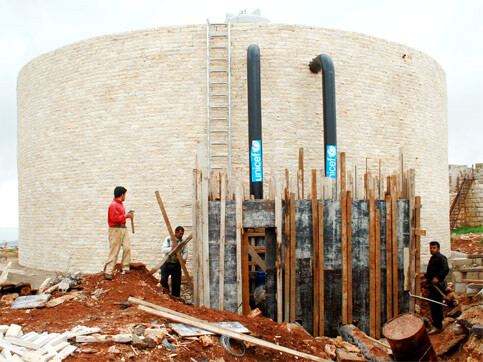Electronic Lebanon 12 March 2007

This dirty reservoir has become the main supply of water for some of Lebanon’s residents. (Serene Assir/IRIN)
KHIYAM, 12 March 2007 (IRIN) - Water supply to hundreds of thousands of people across southern Lebanon remains the priority development issue, say officials, seven months after Israel’s bombardment of the area severely damaged an already inadequate water and sanitation system.
The UN Children’s Agency, UNICEF, is implementing a series of projects across Lebanon to improve water supply, through its Water, Environment, Sanitation and Hygiene (WESH) unit.
According to WESH figures, only 56 percent of Lebanese are connected to the mains water supply, which in poorer rural areas sometimes only works one day a week. Nearly one in three Lebanese buy drinking water while average leakages of 50 percent from pipes leave an annual water shortfall of around 40 per cent, largely supplemented by mobile water trucks.
“Natural water resources in Lebanon are good but there is a culture of abundance,” Mohammed Bendrissi Alami, WESH Senior Programme Officer at UNICEF Beirut, told IRIN.
“People think they have enough so they don’t care. The problem is the management, quality and supply of water, not the natural resources. There has been no emphasis on the sector and the needs of people are not being met,” Alami said.
War damage
Until Israel’s withdrawal from southern Lebanon in 2000, much of the area’s mains water supply came from Israel itself. The already inadequate Lebanese water supply system left behind after the Israeli occupation ended was further damaged by last summer’s 34-day war between Israel and the armed wing of Lebanese political party Hezbollah.
The Israeli bombardment included the destruction of water tanks, springs and pipelines, leaving most of southern Lebanon totally cut off from mains water supply in the immediate aftermath of the war. Israel said it was targeting terrorist infrastructure.
In Khiyam, the mountain-top town’s main 1,000-cubic-metre water tank was partially destroyed by Israeli fire and is now close to being rebuilt with money from WESH’s US $9m annual budget.
WESH is also helping rebuild 12 other water tanks as well as pipelines, and has provided 12 generators to southern towns to keep water pumps working during the daily electricity cuts.
Jihad al-Bina, Hezbollah’s construction company, has repaired the damaged network of pipes in Khiyam, but local leaders say water shortages will continue, and blame the central government for years of neglect.
“We have shortages now and in summer the population of the town will double. We’ve had nothing from Beirut. We are used to that,” said Ahmed Hassan, a community leader. “We need new pumps and new wells, but there is no search for them going on. For that, we would need an efficient government.”

Khiyam’s main 1,000-cubic-metre water tank, which was partially destroyed by Israeli fire, is now close to being rebuilt by UNICEF (Hugh Macleod/IRIN)
Government failings
Until two years ago, Lebanon’s water system was managed by 22 separate institutions. Those have now been reduced to four, but cost recovery on supplying water to the public remains at just 60 percent, according to UNICEF.
A lack of urban planning by central government means homeowners often connect themselves to the mains water supply, while the fixed annual water bill of US $120 and absence of water metres in homes perpetuates disparities of water access for rich and poor.
WESH now joins fortnightly meetings with the government’s Water Establishment for the South department to coordinate strategy.
”We’ve had nothing from Beirut. We are used to that. We need new pumps and new wells, but there is no search for them going on. For that, we would need an efficient government.”
Lebanon suffers huge disparities in the distribution of its water resources across southern areas of the country.
In Sidon, a southerly port city, water supply for the 17-square-kilometre city will remain at three times the requirement of residents until 2025, according to WESH, due to an abundance of natural wells.
By comparison, the poorly supplied mains water system for the council of Nabatiyeh, further south, covers some 800 square kilometres, leading to mains water only three times a week.
Sanitation
WESH’s Alami said sanitation could also rapidly become “a very serious problem for Lebanon, particularly in the south”.
“People are building houses too close to springs, or they are digging septic tanks close to water holes, both of which lead to faeces contaminating drinking water and subsequent diseases such as hepatitis and diarrhoea,” said Alami.
With 70 per cent of Lebanon’s water system lacking any form of sewage treatment, most effluent simply ends up in rivers, further compounding pollution.
By the end of March, 29 gas chlorination systems will have been installed across southern Lebanon, with WESH assistance, to increase water quality, while the EU and World Bank are working on a scheme to build 12 sewage treatment stations across the country.
This item comes to you via IRIN, a UN humanitarian news and information service, but may not necessarily reflect the views of the United Nations or its agencies. All IRIN material may be reposted or reprinted free-of-charge; refer to the copyright page for conditions of use. IRIN is a project of the UN Office for the Coordination of Humanitarian Affairs.
Related Links